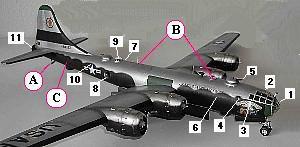|
B-29 FACTS [This beautiful and accurately detailed model of Command Decision
is the work of Christoph Erkens. For Pictures of the Completed Model
and How it was Constructed, CLICK HERE]
 Crew Stations (click for interior views) Crew Stations (click for interior views)
Forward
Pressurized Compartment
1. Bombardier. Also acted as nose gunner when aircraft was under
fighter attack.
2. Aircraft Commander. In modern U. S. aircraft, the chief rides in the
left seat.
3. Pilot. A.K.A. co-pilot.
4. Flight Engineer. Rode backwards behind the pilot facing his
instrument panel
5. Navigator. To the left of the forward turrets. Had window
& bubble to shoot the stars.
6. Radio Operator. Cramped behind turret without a window. Not
for the claustrophobic.
Rear
Pressurized Compartment (connected to forward pressurized compartment by tunnel (B) over bomb
bay)
7. Left Scanner. A.K.A. Left Gunner <click>
to see & learn about gun sight.
8. Right Scanner. A.K.A. Right Gunner
9. Central Fire Controller. Rode in the “barber chair” between left and
right gunners and coordinated firing the remotely controlled guns.
10. Radar Operator. His only outside view was a radar screen.
Tail
Gunner’s Pressurized Compartment
11. Tail Gunner. Rode facing aft in his separate compartment.
Also operated C, putt-putt (power unit) .
Little
Known B-29 Factoid <click>
A. Designed to punish
poor co-pilots who had to buy the crew a case of beer whenever he scraped it
while landing. The tail gunner was responsible for keeping fresh paint
on the skid. Glenn Garig recalls: "The A/C gave me the landing at
Hickam. Seems like I recall coming across the channel at the end of the
runway and really wanted to show off with a squeaker. I did get the
nose pretty high in the air, with a good touch down. I still feel all
the tail gunners carried a file in their bag. It cost me a case, but
they let me help them dispose of it, so we all went away happy."
B. Pressurized Tunnel: Connected front & aft-pressurized
crew compartments above the bomb bays. Had to be crawled through.
If you wanted to keep your own parachute, you had to drag it behind
you. Spares chest packs were usually kept near both ends of the
tunnel. The big danger was explosive depressurization in either
compartment. If that happened, the tunnel suddenly became a cannon and
your body the cannon shell.
C. Putt-Putt: A.K. A. Auxiliary Power Unit. Supplied
power to all the ship's systems for preflight and maintenance. Sounded
more like a lawn mower than a power unit.
|
